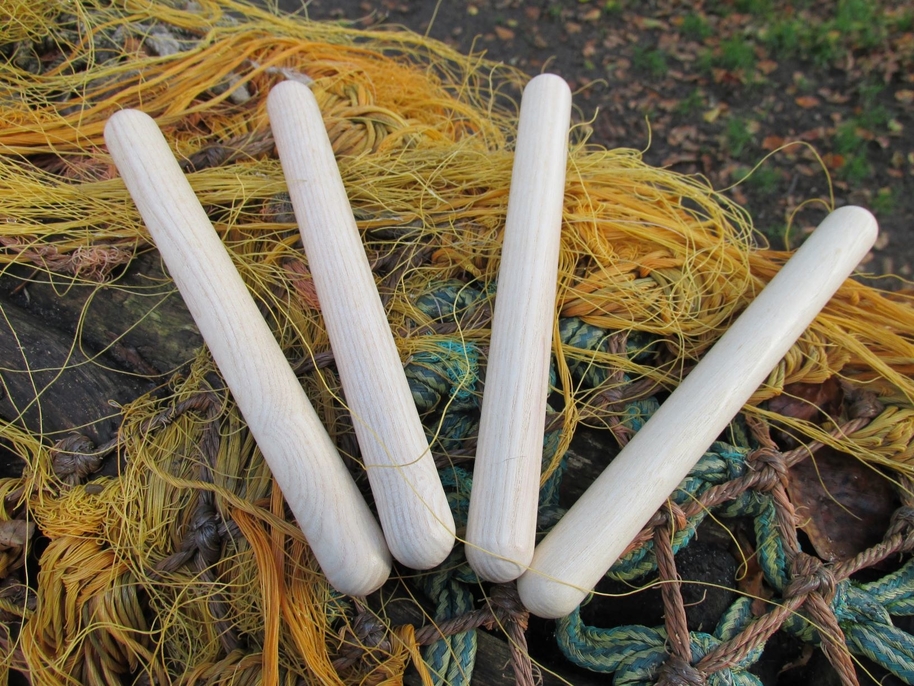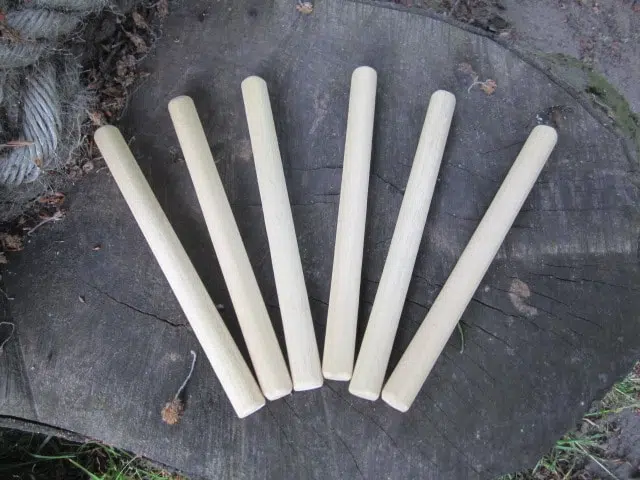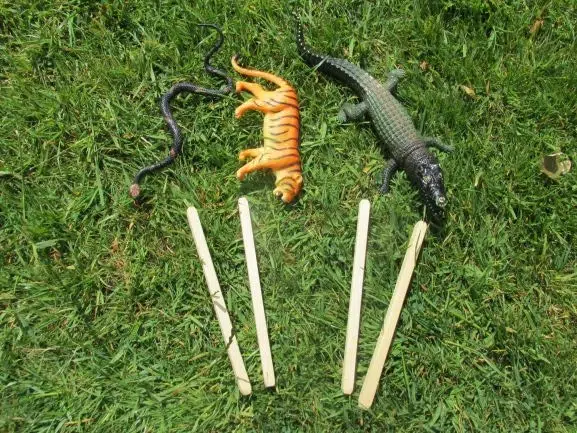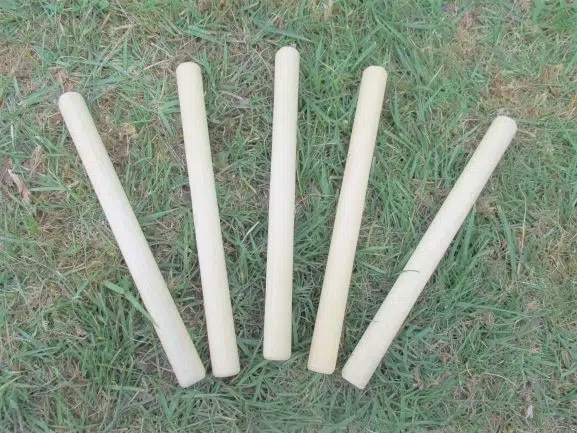You might have heard about rhythm sticks, and possibly rhythm sticks activities, but you’re not really sure what they are.
Is so, then you’ve come to the right place.
Rhythm sticks are one of the ultimate resources for children from the ages of 2 upwards, and can teach many skills. But what are they?
Rhythm sticks are wooden sticks that look like claves. They are normally used in pairs. Rhythm sticks are used for a range of songs, musical games and early phonics activities.
They are so simple, and yet such as rich resource, containing many possibilities.
How can you make them (or buy them)? What are the benefits? What do you use them for? What are the best activities? What are the top tips for using them?
This article answers all of these questions, and sets you up for success with rhythm sticks.

What Rhythm Sticks Are
Rhythm sticks are quite simply any pair of sticks that children can use to hit together.
You can use claves, and the two things are basically the same.
However, there are lots of other things you can use for rhythm sticks which include:
DIY Rhythm Sticks
Make your own!
All you need is some wooden poles, or pieces of dowel. Something like broom-handles would work. Saw them into equal size lengths. Most wood-selling shops will do this for you. The thirty sets that I have where all cut up in one shop into equal lengths (about 21cm) on a big saw. All I needed to do was sand the ends down (a quick job – maybe only 10 seconds per stick).
They are a resource for life, so definitely a good investment for time.

Buy Rhythm Sticks
I have recently bought some, and they are excellent. Here are the ones I got on Amazon. There are probably many other places to find them as well.
Sticks From Outside
For a really natural approach, you can find sticks from outside and use these. These are much quieter than regular rhythm sticks (and they will sometimes snap). However, on the plus side they have a wonderful natural texture, and make it more ‘touchy-feely.’
Chopsticks
For a much quieter experience, you can use chopsticks. These are very cheap to order in bulk.
What They Are Used For
Rhythm sticks are very simple, but they are one of the most versatile resources that exist.
They can be used for all sorts of games, including some of the following:
Songs
The rhythm sticks are great for keeping the beat when singing simple songs, like nursery rhymes. You can also add sound effects, like the different sounds in songs like Old MacDonald or The Wheels On The Bus
Simple Games
Using a few simple props or a toy, you can play all sorts of games with the rhythm sticks. These will involve hitting the syllables in words, or hitting words in a sentence.
Books
There are many simple books you can use with rhythm sticks. Any book that has a repeated sentence in it is great. The children hit the sentence whilst saying it.
Stories
You can make up a story, and hit sound effects in it with the rhythm sticks. This engages many different skills (more about this later).
The Benefits Of Using Rhythm Sticks
But what are the benefits of using rhythm sticks with young children? There are many! And they include:
1.They Are Interactive
This is a big one! When you give out rhythm sticks to children it gets everyone involved at the same time.
2. They Are Multisensory
There is so much going on! Multisensory quite simply means, as you can probably guess, that more than one sense is stimulated at the same time.
This heightens learning and engagement from the children.

Rhythm sticks involve movement, and they also involve sound. They mix music and language (if you play the right games). All of this is the perfect formula for learning.
3.Good For Behavior
General speaking, I have always found them a positive tool for behavior. I think it is because they get everyone involved, and so there is more of an emphasis on ‘doing’ rather than sitting and listening.
4.Good For Rhythm
The clue is definitely in the name for this one – yes, rhythm sticks are definitely great for rhythm.
What is rhythm? Rhythm is several things in this context: it is understanding how words are broken up into syllables. (For the best 17 syllables games, take a look at this article) It is also understanding how sentences are broken up into words. Rhythm sticks can help with both these things.
Also, there is the rhythm of sound, and again rhythm sticks can be used to join in with music and songs and help to begin an understanding of rhythm in this way.
5.Teach Early Listening
Because they are interesting and fun to use, they get children engaged.
They will be listening much more closely: to the game, to the words, to the song – whatever it is, rhythm sticks really help this listening process.
They are great at teaching simple skills like eye contact. (For twelve of the best eye contact games, check this article out).
6.They Help Teach A Range Of Phonic Skills
Rhythm sticks are incredibly versatile. In particular, they are good for some of the following:
- Teaching segmenting. This is splitting up words into their sounds. (For a full guide on what segmenting is, and the best ways to teach it, take a look at this article)
- Teaching about loud and quiet/fast and slow. You can hit them in all sorts of different ways and learn about how sound works!
- Teaching rhythm – syllables, sounds, and sentences
- Keep the beat. This is a really important skill for young children. Those that are able to keep a beat, have been found in studies to do much better at school in general. (Source)
The Best Rhythm Sticks Activities
Here are a selection of a few of the best rhythm sticks activities. To find out a full guide to many more, then check this article out.
1.Chop Chop Choppity Chop
This is a great syllables game.
All you need for this is a few pieces of food in a bag. You could use real food, or it could be pretend food. Whichever is fine.

It is good to pick foods that have different numbers of syllables in their names. For example, a ‘cake’ (one syllable), a ‘sausage’ (two), and a ‘cucumber’ (three) would be perfect for this.
There is a classic chant that goes like this:
Chop! Chop! Choppity chop!
Chop off the bottom and chop off the top!
All say the chant, and hit the beat of the chant as you go with the sticks.
Then pick one child to take out a piece of food from the bag. Whatever they take out, you all say the word, hit it with the sticks, and then count the syllables.
So, for example, if it was the cucumber, you all go ‘cu (hit)-cum-(hit) -ber (hit)! One (hit)-two (hit)-three (hit)!’ Repeat this two or three times, so they start to understand what is going on. (You are hitting the syllables at the same time as you say them, by the way)
Repeat for different food.
2.Music Doll
This is an excellent activity for exploring musical vocabulary like ‘loud’, ‘quiet’, ‘fast’ and ‘slow’.
Have a toy for this – it can be pretty much anything. I use a baby doll that has different musical instruments hanging from her, but any teddy or puppet would be great.
The toy whispers in your ear how to paly the rhythm sticks.
For example, play them ‘loud’. They play them loudly!
Play them ‘slowly’ – they hit them slowly. It really is that simple. It just makes it so much more exciting that the puppet or toy is leading the way.
If the children are great at this, you can extend this game in different ways, including:
- Use more unusual vocabulary, such as ‘play them thunderously’, ‘play them rapidly’.
- Combine more than one word at the same time. For example, ‘Can you play them loudly and slowly’. This really gets them thinking and exploring sounds in many different ways.
3.Hit The Sentence
This is a great one for splitting up language into words.
It also lays the foundations for early sentence writing (that will happen later on in the process)
I have a song to start this one, that goes to the music of the Adam’s Family. The words are:
Hit the words! (hit hit)
Hit the words! (hit hit)
Hit the words! Hit the words! Hit the words! (Hit hit)
You give the children a simple phrase, and then all hit the words together. For example, it might be ‘brush your teeth!’
Get them to hit ‘brush (hit) your (hit) teeth (hit)! One (hit) two (hit) three (hit).’ Repeat a few times each sentence. (Once again, the hits are coming as you say the word)
Good ways to jazz this one up include:
-Using more complex sentences
-Saying the sentences in silly voice, like a ghost or a zombie
-Older children can hit written sentences
4.Making Up Stories
This is excellent for listening and attention, rhythm, and also loud/soft.
You quite simply make up a story, and the children bring it to life with sound effects with the sticks!
For example, you could have a giant going ‘stamp stamp’ (hit the sticks hard). Or you could have a little mouse going ‘squeak squeak squeak’ (hit them really softly).
Great for characters running, jumping, stamping, flying, shouting, eating, roaring, and all that kind of thing!
Just make the story up. If the children can get involved and help you to add to parts of the story then brilliant – that is just what you want.
If you are looking for more interactive storytelling ideas, then check this article out.
Things That May Go Wrong – And How To Solve The Problems
Like anything in early education, many common things might go wrong when you use rhythm sticks.
Here are some things that you may well see, and some top tips with how to deal with these issues:
Problem – You give out the sticks and they all start hitting them before you start, making explaining any game impossible
Like anything when dealing with children, it is essential to get off to a good start. The way you start dictates often how well something will go. Start badly, and what follows is usually pretty much doomed.
I always start any rhythm sticks session by showing the children how to hold them to start. This is crucial! Give them out, and get them to hold them both together, with both hand around them (like you would grip a baseball bat). You could even hold them like this to your chest.
Give them out quickly! This aids the possibility of things going well.
Also take them off anyone that is not doing it (and give them back after a few moments). It is better to be as firm as possible when starting off.
Problem – Children hit each other
This is another one to take immediate action over.
Stop them! Any violence, take the sticks off the person immediately. Most children will learn from this, and want to get the sticks back and have a fresh start.
Problem – Children can’t keep a beat or attempt the skills in the game
This is perfectly normal. The skills described in this article take time to develop.
Try to tailor the activities to the children’s skills, and start as simply as you can. But, like everything, practice is the way to improve.

Top Tips For Using Rhythm Sticks
- Make your own, or use chopsticks, sticks or claves
- Start an activity as you mean to go on
- Use puppets and props to bring activities to life
- Use them to develop a range of skills
- Repeat games regularly – the more you repeat the same game, the better the children will get. Practice leads to mastery
- Making rhythm sticks part of your routine
- Use them at home (as a parent with your child), or in school or preschool
Conclusion
Rhythm sticks are so simple, and yet one of the ultimate resources.
They make teaching and learning completely interactive, and multisensory. They are also excellent for behavior. Often the cheapest and simplest solutions are the best in education, and rhythm sticks definitely tick both of these boxes.
If you’ve enjoyed this article, then the next step is to check out my next article – Rhythm Sticks Activities – The Complete Guide.
